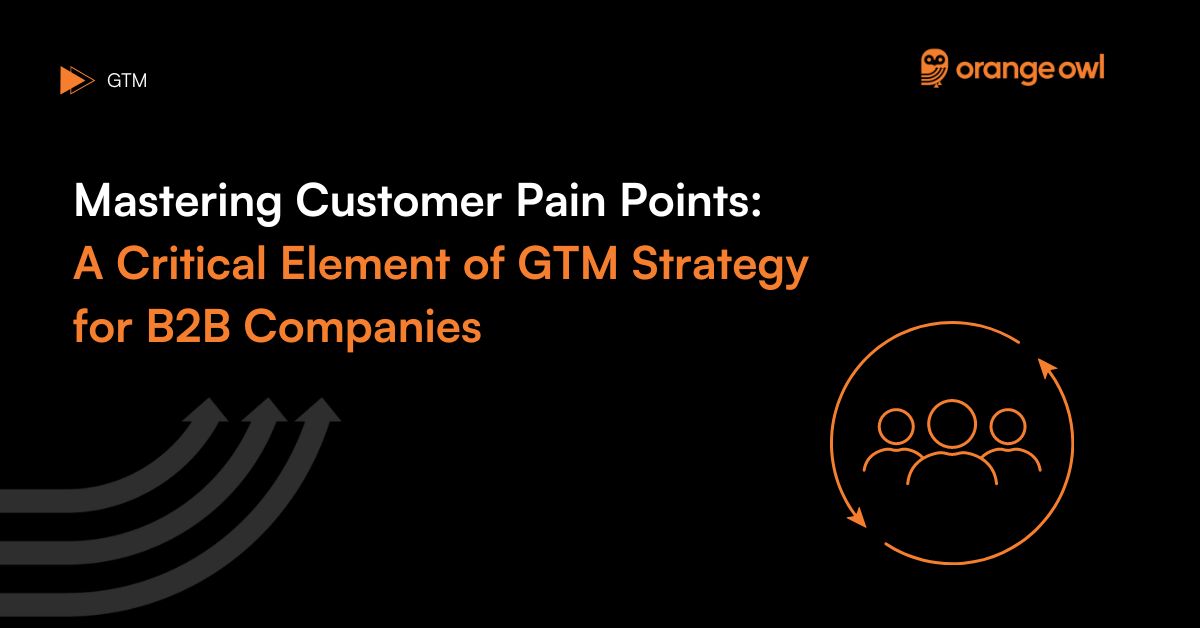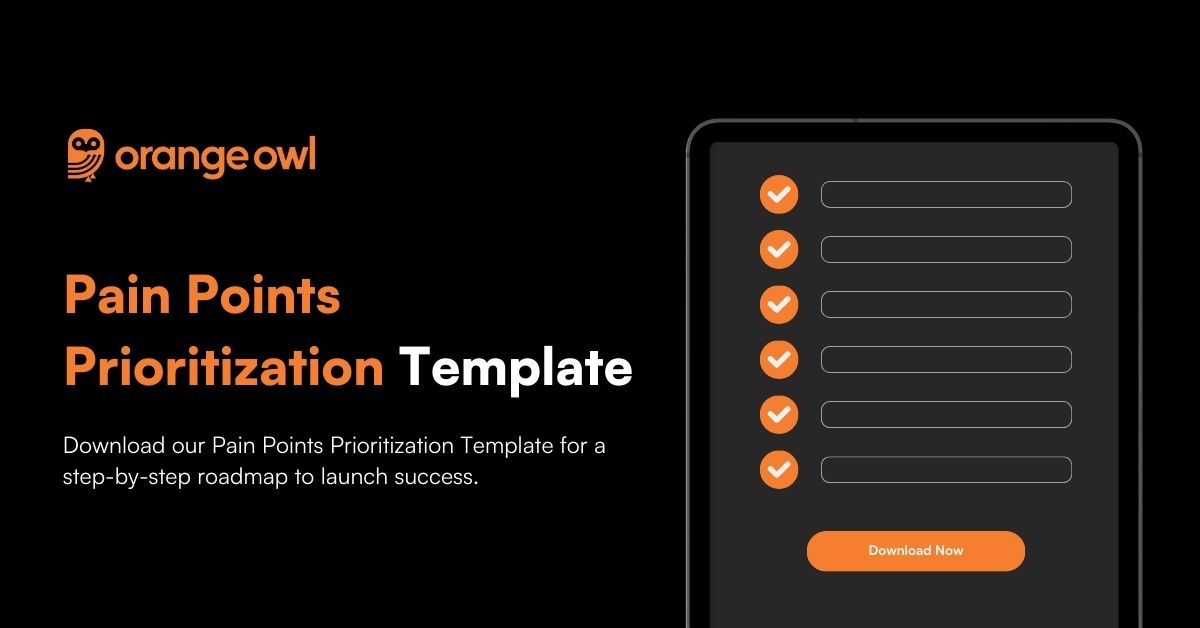Mastering Customer Pain Points: A Critical Element of GTM Strategy for B2B Companies
Orange Owl
February 1, 2025

Table of Contents
In the competitive landscape of B2B industries, understanding and addressing customer pain points is crucial for the success of any Go-To-Market (GTM) strategy. Also, 30% of B2B marketing decision makers consider understanding and speaking about the customer’s pain points the most important point of marketing and sales online. This blog explores how B2B companies can effectively study and resolve pain points as part of crafting a robust GTM plan, using project management tools as an illustrative example.

What are Customer Pain Points?
Customer pain points are the hurdles or challenges that customers encounter while interacting with a company, its products, or its services. These can show up in several ways:
- Process Pain Points: Internal procedures within the organization that hinder the customer journey, such as complicated sales transactions or prolonged deployment times.
- Financial Pain Points: Issues related to the costs of doing business with the company, such as hidden fees or expensive membership charges.
- Support Pain Points: Challenges faced during interactions with sales and customer service teams, such as slow response times or insufficient product knowledge.
- Product Pain Points: Deficiencies in the company’s products or services that hinder customer productivity or prevent them from achieving desired results, such as inconvenient workflows or underwhelming features.
The Importance of Addressing Customer Pain Points
Addressing customer pain points isn’t just about resolving immediate issues; it’s about fostering a customer-centric culture and building lasting relationships. By understanding and addressing these pain points, companies can:
- Enhance Customer Satisfaction: Resolving pain points leads to a more positive customer experience, increasing overall satisfaction and loyalty.
- Improve Retention Rates: Customers are more likely to remain loyal to companies that actively address their pain points and prioritize their needs.
- Drive Business Growth: By delivering exceptional customer experiences, companies can attract new customers through positive word-of-mouth and referrals.
- Gain Competitive Advantage: Companies that effectively address customer pain points differentiate themselves in the market and stand out from competitors.
Crafting Solutions to Address Pain Points
Successfully addressing customer pain points requires a systematic approach that integrates the identification, prioritization, and resolution of these issues into the company’s GTM strategy. Here’s how businesses can effectively tackle customer pain points:

Step 1: Identify Common Pain Points
Identifying pain points begins with comprehensive market research. Gather data through various channels like customer interviews, surveys, support ticket analysis, and social media monitoring. For example, a company developing a new project management tool might discover that potential users are frustrated with the existing tools’ lack of integration capabilities or real-time collaboration features.
Expert Insight: Utilize analytical tools like sentiment analysis on customer feedback to quantitatively identify and categorize common pain points.
Step 2: Prioritize Pain Points
After identification, the next step is to prioritize these pain points based on their impact on potential customers and the feasibility of addressing them. Prioritization helps focus resources on areas that will most significantly affect customer decisions and satisfaction.
Example: If both ‘lack of integration’ and ‘complex user interfaces’ are identified as pain points, but ‘lack of integration’ affects a larger segment of the target market, it should be prioritized.
Step 3: Develop Solutions
Developing solutions to these pain points involves innovating or improving your product. This might mean adding new features, enhancing existing functionalities, or even redesigning the user experience to better meet customer needs.
For instance, incorporating API integrations in a project management tool can address the pain point of lack of integration by allowing users to seamlessly connect with other software they are currently using.
Innovative Tip: Consider developing modular features that customers can choose based on their specific needs, enhancing customization and user satisfaction.
Step 4: Communicate Your Solutions
Effectively communicate how your product solves these pain points. This involves clear messaging through your marketing channels, demonstrating the direct benefits of your solutions to the pain points identified.
Marketing Strategy: Use testimonials and case studies in your communications to show real-world applications of how your product resolves these pain points.
Step 5: Iterate and Improve
Lastly, the GTM strategy should include a plan for ongoing feedback collection and product iteration. Markets evolve, and so do customer needs; continuous improvement based on customer feedback ensures the product remains relevant and competitive.
Continuous Improvement Strategy
Establish regular review cycles and update your GTM strategy based on customer feedback and market changes.
Conclusion
Addressing customer pain points is essential, not just for product development but as a core component of an effective GTM strategy for any B2B company. By focusing on these pain points, companies can better align their products with market needs, improve customer satisfaction, and increase the effectiveness of their market entry and growth strategies.
This structured approach to understanding and solving customer pain points helps ensure that your GTM strategy is not only relevant but also compelling to your target audience, setting the stage for successful market penetration and growth.
Frequently Asked Questions (FAQs) about Customer Pain points for B2B companies
Customer pain points are specific problems or challenges that customers encounter while interacting with a company’s products, services, or processes. These can be related to internal processes, financial costs, support services, or product deficiencies.
Addressing pain points is essential because it enhances customer satisfaction, improves retention rates, drives business growth, and provides a competitive advantage. By solving these issues, companies can better meet customer needs and differentiate themselves in the market.
Companies can identify pain points through comprehensive market research, including customer interviews, surveys, support ticket analysis, and social media monitoring. Analytical tools like sentiment analysis can also help quantify and categorize these issues.
Companies should prioritize pain points based on their impact on potential customers and the feasibility of addressing them. This ensures that resources are focused on areas that will most significantly affect customer decisions and satisfaction.
Communication is key to demonstrating how your product solves identified pain points. Clear messaging through marketing channels, using testimonials and case studies, can show real-world applications of your solutions and their benefits to customers.
Companies should establish regular review cycles to collect ongoing feedback and update their GTM strategy accordingly. This ensures that the product remains relevant and competitive as market conditions and customer needs evolve.
Testimonials and case studies provide real-world evidence of how your product resolves specific pain points. They build credibility and trust, showing potential customers the practical benefits and effectiveness of your solutions.
By resolving pain points, companies can enhance customer satisfaction and loyalty, leading to positive word-of-mouth and referrals. This attracts new customers and fosters long-term relationships, driving sustainable business growth.
Innovative approaches include developing modular features that customers can choose based on their specific needs, enhancing customization and user satisfaction. Additionally, leveraging technology for real-time feedback and rapid iteration can also address pain points more effectively.



